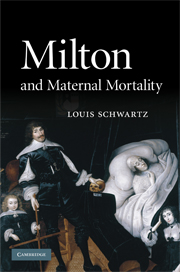Book contents
- Frontmatter
- Contents
- Acknowledgments
- Abbreviations
- Introduction
- PART I BEHIND THE VEIL: CHILDBIRTH AND THE NATURE OF OBSTETRIC ANXIETY IN EARLY MODERN ENGLAND
- 1 “Exquisitt torment” and “infinitt grace”: maternal suffering and the rites of childbirth
- 2 When things went wrong: maternal mortality and obstetric anxiety
- 3 Religious frameworks
- PART II “SCARCE-WELL-LIGHTED FLAME”: THE REPRESENTATION OF MATERNAL MORTALITY IN MILTON'S EARLY POETRY
- PART III “CONSCIOUS TERROURS”: THE PROBLEM OF MATERNAL MORTALITY IN MILTON'S LATER POETRY
- Index
- References
3 - Religious frameworks
Published online by Cambridge University Press: 04 December 2009
- Frontmatter
- Contents
- Acknowledgments
- Abbreviations
- Introduction
- PART I BEHIND THE VEIL: CHILDBIRTH AND THE NATURE OF OBSTETRIC ANXIETY IN EARLY MODERN ENGLAND
- 1 “Exquisitt torment” and “infinitt grace”: maternal suffering and the rites of childbirth
- 2 When things went wrong: maternal mortality and obstetric anxiety
- 3 Religious frameworks
- PART II “SCARCE-WELL-LIGHTED FLAME”: THE REPRESENTATION OF MATERNAL MORTALITY IN MILTON'S EARLY POETRY
- PART III “CONSCIOUS TERROURS”: THE PROBLEM OF MATERNAL MORTALITY IN MILTON'S LATER POETRY
- Index
- References
Summary
As much of what I have already said makes clear, in Milton's world, religious beliefs and practices were central to the ways in which people accommodated themselves to the difficulty of their obstetric experiences, providing what David Cressy calls the era's “master-narrative for understanding the mystery of childbirth.” While the religious practices of the birthing chamber sometimes edged over into the manipulation of charms, magical incantations, and sacred relics of various kinds (the last being the most common hold-over from earlier Catholic practices), the central rites of childbirth were, along with the churching ceremony, a series of individual and group prayers and meditations performed by the mother, her attendants, her family members, and other interested members of her community in preparation for her coming labor. These were, for the most part, conducted in the birthing chamber itself and in the domestic and social circles that surrounded it, and they drew on a particular set of theological concepts, devotional traditions, and biblical passages and images. The purpose of these practices, along with the various social and practical aspects of the childbirth rites as a whole, was to help women and others involved with the birth cope with their fears about what might happen, and they worked by turning what could inspire despair into an opportunity for the demonstration of a confident faith. Prayers and meditations were, of course, also thought of as practically efficacious.
- Type
- Chapter
- Information
- Milton and Maternal Mortality , pp. 49 - 76Publisher: Cambridge University PressPrint publication year: 2009



